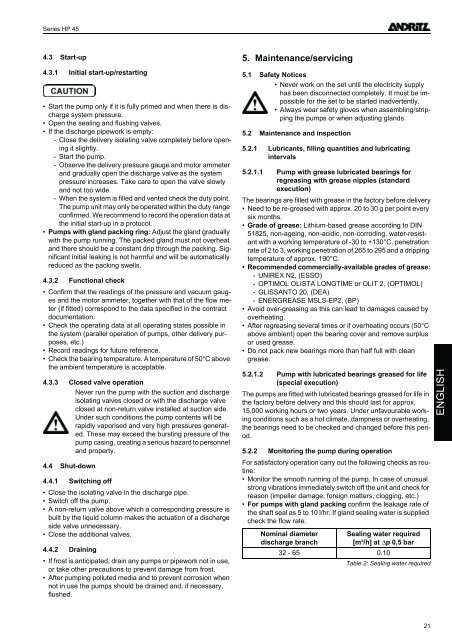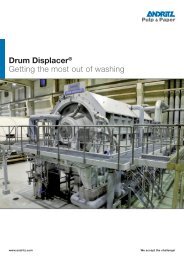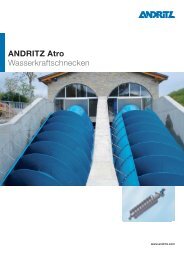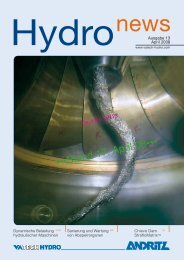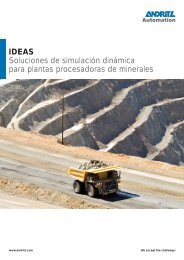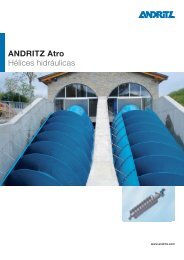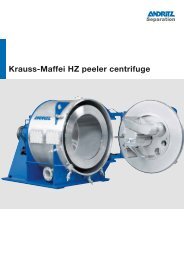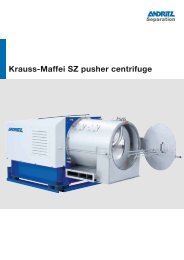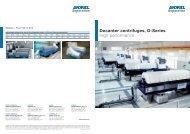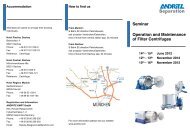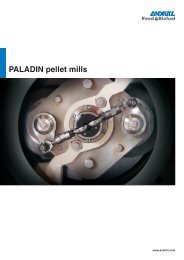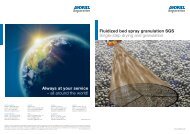Betriebsanleitung Operating Instructions Instructions de ... - Andritz
Betriebsanleitung Operating Instructions Instructions de ... - Andritz
Betriebsanleitung Operating Instructions Instructions de ... - Andritz
You also want an ePaper? Increase the reach of your titles
YUMPU automatically turns print PDFs into web optimized ePapers that Google loves.
Series HP 45<br />
4.3 Start-up<br />
5. Maintenance/servicing<br />
4.3.1 Initial start-up/restarting<br />
• Start the pump only if it is fully primed and when there is discharge<br />
system pressure.<br />
• Open the sealing and flushing valves.<br />
• If the discharge pipework is empty:<br />
- Close the <strong>de</strong>livery isolating valve completely before opening<br />
it slightly.<br />
- Start the pump.<br />
- Observe the <strong>de</strong>livery pressure gauge and motor ammeter<br />
and gradually open the discharge valve as the system<br />
pressure increases. Take care to open the valve slowly<br />
and not too wi<strong>de</strong>.<br />
- When the system is filled and vented check the duty point.<br />
The pump unit may only be operated within the duty range<br />
confirmed. We recommend to record the operation data at<br />
the initial start-up in a protocol.<br />
• Pumps with gland packing ring: Adjust the gland gradually<br />
with the pump running. The packed gland must not overheat<br />
and there should be a constant drip through the packing. Significant<br />
initial leaking is not harmful and will be automatically<br />
reduced as the packing swells.<br />
4.3.2 Functional check<br />
• Confirm that the readings of the pressure and vacuum gauges<br />
and the motor ammeter, together with that of the flow meter<br />
(if fitted) correspond to the data specified in the contract<br />
documentation.<br />
• Check the operating data at all operating states possible in<br />
the system (parallel operation of pumps, other <strong>de</strong>livery purposes,<br />
etc.)<br />
• Record readings for future reference.<br />
• Check the bearing temperature. A temperature of 50°C above<br />
the ambient temperature is acceptable.<br />
4.3.3 Closed valve operation<br />
Never run the pump with the suction and discharge<br />
isolating valves closed or with the discharge valve<br />
closed at non-return valve installed at suction si<strong>de</strong>.<br />
Un<strong>de</strong>r such conditions the pump contents will be<br />
rapidly vaporised and very high pressures generated.<br />
These may exceed the bursting pressure of the<br />
pump casing, creating a serious hazard to personnel<br />
and property.<br />
4.4 Shut-down<br />
4.4.1 Switching off<br />
• Close the isolating valve in the discharge pipe.<br />
• Switch off the pump.<br />
• A non-return valve above which a corresponding pressure is<br />
built by the liquid column makes the actuation of a discharge<br />
si<strong>de</strong> valve unnecessary.<br />
• Close the additional valves.<br />
4.4.2 Draining<br />
• If frost is anticipated, drain any pumps or pipework not in use,<br />
or take other precautions to prevent damage from frost.<br />
• After pumping polluted media and to prevent corrosion when<br />
not in use the pumps should be drained and, if necessary,<br />
flushed.<br />
5.1 Safety Notices<br />
• Never work on the set until the electricity supply<br />
has been disconnected completely. It must be impossible<br />
for the set to be started inadvertently.<br />
• Always wear safety gloves when assembling/stripping<br />
the pumps or when adjusting glands.<br />
5.2 Maintenance and inspection<br />
5.2.1 Lubricants, filling quantities and lubricating<br />
intervals<br />
5.2.1.1 Pump with grease lubricated bearings for<br />
regreasing with grease nipples (standard<br />
execution)<br />
The bearings are filled with grease in the factory before <strong>de</strong>livery<br />
• Need to be re-greased with approx. 20 to 30 g per point every<br />
six months.<br />
• Gra<strong>de</strong> of grease: Lithium-based grease according to DIN<br />
51825, non-ageing, non-acidic, non-corroding, water-resistant<br />
with a working temperature of -30 to +130°C, penetration<br />
rate of 2 to 3, working penetration of 265 to 295 and a dripping<br />
temperature of approx. 190°C.<br />
• Recommen<strong>de</strong>d commercially-available gra<strong>de</strong>s of grease:<br />
- UNIREX N2, (ESSO)<br />
- OPTIMOL OLISTA LONGTIME or OLIT 2, (OPTIMOL)<br />
- GLISSANTO 20, (DEA)<br />
- ENERGREASE MSLS-EP2, (BP)<br />
• Avoid over-greasing as this can lead to damages caused by<br />
overheating.<br />
• After regreasing several times or if overheating occurs (50°C<br />
above ambient) open the bearing cover and remove surplus<br />
or used grease.<br />
• Do not pack new bearings more than half full with clean<br />
grease.<br />
5.2.1.2 Pump with lubricated bearings greased for life<br />
(special execution)<br />
The pumps are fitted with lubricated bearings greased for life in<br />
the factory before <strong>de</strong>livery and this should last for approx.<br />
15,000 working hours or two years. Un<strong>de</strong>r unfavourable working<br />
conditions such as a hot climate, dampness or overheating,<br />
the bearings need to be checked and changed before this period.<br />
5.2.2 Monitoring the pump during operation<br />
For satisfactory operation carry out the following checks as routine:<br />
• Monitor the smooth running of the pump. In case of unusual<br />
strong vibrations immediately switch off the unit and check for<br />
reason (impeller damage, foreign matters, clogging, etc.)<br />
• For pumps with gland packing confirm the leakage rate of<br />
the shaft seal as 5 to 10 l/hr. If gland sealing water is supplied<br />
check the flow rate.<br />
Nominal diameter<br />
discharge branch<br />
Sealing water required<br />
[m³/h] at Δp 0,5 bar<br />
32 - 65 0.10<br />
Table 2: Sealing water required<br />
ENGLISH<br />
21


